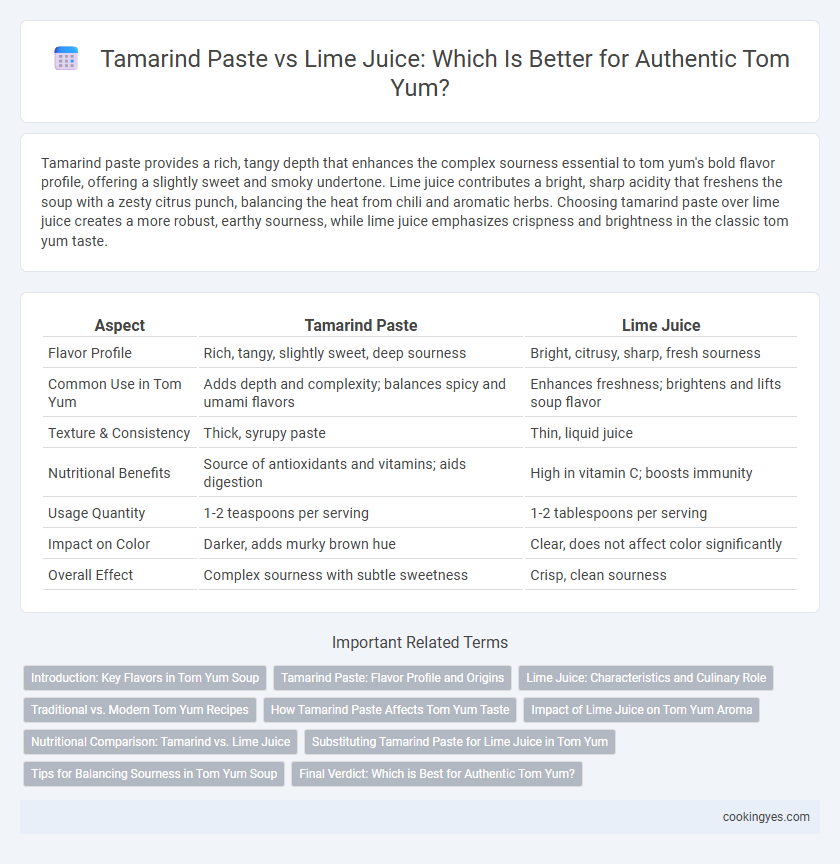Tamarind paste provides a rich, tangy depth that enhances the complex sourness essential to tom yum's bold flavor profile, offering a slightly sweet and smoky undertone. Lime juice contributes a bright, sharp acidity that freshens the soup with a zesty citrus punch, balancing the heat from chili and aromatic herbs. Choosing tamarind paste over lime juice creates a more robust, earthy sourness, while lime juice emphasizes crispness and brightness in the classic tom yum taste.
Table of Comparison
| Aspect | Tamarind Paste | Lime Juice |
|---|---|---|
| Flavor Profile | Rich, tangy, slightly sweet, deep sourness | Bright, citrusy, sharp, fresh sourness |
| Common Use in Tom Yum | Adds depth and complexity; balances spicy and umami flavors | Enhances freshness; brightens and lifts soup flavor |
| Texture & Consistency | Thick, syrupy paste | Thin, liquid juice |
| Nutritional Benefits | Source of antioxidants and vitamins; aids digestion | High in vitamin C; boosts immunity |
| Usage Quantity | 1-2 teaspoons per serving | 1-2 tablespoons per serving |
| Impact on Color | Darker, adds murky brown hue | Clear, does not affect color significantly |
| Overall Effect | Complex sourness with subtle sweetness | Crisp, clean sourness |
Introduction: Key Flavors in Tom Yum Soup
Tamarind paste and lime juice are essential for balancing the distinctive sourness in tom yum soup, each contributing unique flavor profiles. Tamarind paste adds a deep, earthy tanginess with subtle sweetness, enhancing the soup's complexity and richness. Lime juice delivers a sharp, bright acidity that elevates the fresh, zesty notes, creating the signature vibrant punch characteristic of authentic tom yum.
Tamarind Paste: Flavor Profile and Origins
Tamarind paste, a key ingredient in traditional Tom Yum, imparts a rich, tangy, and slightly sweet flavor that balances the soup's spicy and sour elements. Originating from tropical Africa and widely used in Southeast Asian cuisine, tamarind paste adds depth and complexity unmatched by lime juice. Its unique combination of tartness and subtle sweetness enhances the broth's savory notes, making it essential for authentic Tom Yum recipes.
Lime Juice: Characteristics and Culinary Role
Lime juice is a key ingredient in Tom Yum, contributing a fresh, tangy acidity that balances the soup's spicy and savory flavors. Its bright citrus notes enhance the aromatic herbs like lemongrass and kaffir lime leaves, intensifying the overall depth of flavor. Unlike tamarind paste, lime juice preserves the light, zesty profile essential for the authentic Thai taste of Tom Yum.
Traditional vs. Modern Tom Yum Recipes
Tamarind paste is a traditional ingredient in classic Tom Yum recipes, providing a rich, deep sourness that balances the dish's spicy and savory flavors. Lime juice, commonly used in modern adaptations, delivers a brighter, sharper acidity that freshens the soup and enhances its herbal notes. The choice between tamarind paste and lime juice significantly influences the soup's flavor profile, reflecting the evolution from authentic preparations to contemporary variations in Tom Yum cuisine.
How Tamarind Paste Affects Tom Yum Taste
Tamarind paste imparts a rich, tangy depth to tom yum, enhancing its signature sourness with a subtle sweetness that lime juice alone cannot replicate. Its complex, slightly fruity acidity balances the spicy and herbal flavors, creating a more rounded and layered taste profile. Unlike lime juice, tamarind paste adds a smooth, dense texture that intensifies the soup's overall savoriness and complexity.
Impact of Lime Juice on Tom Yum Aroma
Lime juice enhances Tom Yum's aroma by imparting a bright, citrusy fragrance that elevates the soup's fresh, zesty profile, distinguishing it from the deeper, tangier notes contributed by tamarind paste. The volatile oils in lime juice release essential citrus aromas that intensify the overall sensory experience, making the broth more vibrant and lively. This aromatic boost from lime juice plays a critical role in balancing the spicy, herbal, and savory components characteristic of authentic Tom Yum.
Nutritional Comparison: Tamarind vs. Lime Juice
Tamarind paste provides a rich source of antioxidants, vitamins B and C, and dietary fiber, contributing to digestive health in Tom yum soup. Lime juice is high in vitamin C and citric acid, which enhance immunity and add a refreshing tang without extra calories. Both ingredients offer distinct nutritional benefits, with tamarind adding depth and fiber and lime juice providing a bright acidity essential for flavor balance.
Substituting Tamarind Paste for Lime Juice in Tom Yum
Substituting tamarind paste for lime juice in tom yum enhances the soup's depth with a rich, tangy sweetness that lime juice's sharp acidity lacks. Tamarind paste provides a complex sourness and subtle fruity undertones, balancing the spicy, aromatic flavors of lemongrass and galangal. This swap maintains the signature tartness while introducing a unique, mellow sour note that elevates authentic Thai culinary experience.
Tips for Balancing Sourness in Tom Yum Soup
Tamarind paste and lime juice both provide essential sourness in Tom Yum soup, but tamarind paste offers a deeper, slightly sweet tang while lime juice delivers a sharp, fresh acidity. Balancing sourness involves starting with a small amount of tamarind paste to create a subtle base, then adjusting with lime juice to enhance brightness without overpowering other flavors. Taste frequently during cooking to achieve the perfect harmony between sour, spicy, and savory notes characteristic of authentic Tom Yum.
Final Verdict: Which is Best for Authentic Tom Yum?
Tamarind paste delivers a deep, tangy sweetness that enhances the complex sourness essential for authentic Tom Yum, while lime juice offers a sharp, fresh acidity that brightens the broth. Traditional recipes frequently prioritize tamarind paste for its layered flavor profile that balances the spicy and savory elements characteristic of genuine Thai cuisine. For the ultimate authentic Tom Yum experience, tamarind paste remains the preferred choice over lime juice.
Tamarind Paste vs Lime Juice for Tom yum Infographic

 cookingyes.com
cookingyes.com